Minjae Kim
THEME : Enhancing Thematic Investing with Semantic Stock Representations and Temporal Dynamics
Aug 23, 2025Abstract:Thematic investing aims to construct portfolios aligned with structural trends, yet selecting relevant stocks remains challenging due to overlapping sector boundaries and evolving market dynamics. To address this challenge, we construct the Thematic Representation Set (TRS), an extended dataset that begins with real-world thematic ETFs and expands upon them by incorporating industry classifications and financial news to overcome their coverage limitations. The final dataset contains both the explicit mapping of themes to their constituent stocks and the rich textual profiles for each. Building on this dataset, we introduce \textsc{THEME}, a hierarchical contrastive learning framework. By representing the textual profiles of themes and stocks as embeddings, \textsc{THEME} first leverages their hierarchical relationship to achieve semantic alignment. Subsequently, it refines these semantic embeddings through a temporal refinement stage that incorporates individual stock returns. The final stock representations are designed for effective retrieval of thematically aligned assets with strong return potential. Empirical results show that \textsc{THEME} outperforms strong baselines across multiple retrieval metrics and significantly improves performance in portfolio construction. By jointly modeling thematic relationships from text and market dynamics from returns, \textsc{THEME} provides a scalable and adaptive solution for navigating complex investment themes.
Fine-Grained Perturbation Guidance via Attention Head Selection
Jun 12, 2025Abstract:Recent guidance methods in diffusion models steer reverse sampling by perturbing the model to construct an implicit weak model and guide generation away from it. Among these approaches, attention perturbation has demonstrated strong empirical performance in unconditional scenarios where classifier-free guidance is not applicable. However, existing attention perturbation methods lack principled approaches for determining where perturbations should be applied, particularly in Diffusion Transformer (DiT) architectures where quality-relevant computations are distributed across layers. In this paper, we investigate the granularity of attention perturbations, ranging from the layer level down to individual attention heads, and discover that specific heads govern distinct visual concepts such as structure, style, and texture quality. Building on this insight, we propose "HeadHunter", a systematic framework for iteratively selecting attention heads that align with user-centric objectives, enabling fine-grained control over generation quality and visual attributes. In addition, we introduce SoftPAG, which linearly interpolates each selected head's attention map toward an identity matrix, providing a continuous knob to tune perturbation strength and suppress artifacts. Our approach not only mitigates the oversmoothing issues of existing layer-level perturbation but also enables targeted manipulation of specific visual styles through compositional head selection. We validate our method on modern large-scale DiT-based text-to-image models including Stable Diffusion 3 and FLUX.1, demonstrating superior performance in both general quality enhancement and style-specific guidance. Our work provides the first head-level analysis of attention perturbation in diffusion models, uncovering interpretable specialization within attention layers and enabling practical design of effective perturbation strategies.
Structuring the Unstructured: A Multi-Agent System for Extracting and Querying Financial KPIs and Guidance
May 25, 2025Abstract:Extracting structured and quantitative insights from unstructured financial filings is essential in investment research, yet remains time-consuming and resource-intensive. Conventional approaches in practice rely heavily on labor-intensive manual processes, limiting scalability and delaying the research workflow. In this paper, we propose an efficient and scalable method for accurately extracting quantitative insights from unstructured financial documents, leveraging a multi-agent system composed of large language models. Our proposed multi-agent system consists of two specialized agents: the \emph{Extraction Agent} and the \emph{Text-to-SQL Agent}. The \textit{Extraction Agent} automatically identifies key performance indicators from unstructured financial text, standardizes their formats, and verifies their accuracy. On the other hand, the \textit{Text-to-SQL Agent} generates executable SQL statements from natural language queries, allowing users to access structured data accurately without requiring familiarity with the database schema. Through experiments, we demonstrate that our proposed system effectively transforms unstructured text into structured data accurately and enables precise retrieval of key information. First, we demonstrate that our system achieves approximately 95\% accuracy in transforming financial filings into structured data, matching the performance level typically attained by human annotators. Second, in a human evaluation of the retrieval task -- where natural language queries are used to search information from structured data -- 91\% of the responses were rated as correct by human evaluators. In both evaluations, our system generalizes well across financial document types, consistently delivering reliable performance.
HARDMath2: A Benchmark for Applied Mathematics Built by Students as Part of a Graduate Class
May 17, 2025Abstract:Large language models (LLMs) have shown remarkable progress in mathematical problem-solving, but evaluation has largely focused on problems that have exact analytical solutions or involve formal proofs, often overlooking approximation-based problems ubiquitous in applied science and engineering. To fill this gap, we build on prior work and present HARDMath2, a dataset of 211 original problems covering the core topics in an introductory graduate applied math class, including boundary-layer analysis, WKB methods, asymptotic solutions of nonlinear partial differential equations, and the asymptotics of oscillatory integrals. This dataset was designed and verified by the students and instructors of a core graduate applied mathematics course at Harvard. We build the dataset through a novel collaborative environment that challenges students to write and refine difficult problems consistent with the class syllabus, peer-validate solutions, test different models, and automatically check LLM-generated solutions against their own answers and numerical ground truths. Evaluation results show that leading frontier models still struggle with many of the problems in the dataset, highlighting a gap in the mathematical reasoning skills of current LLMs. Importantly, students identified strategies to create increasingly difficult problems by interacting with the models and exploiting common failure modes. This back-and-forth with the models not only resulted in a richer and more challenging benchmark but also led to qualitative improvements in the students' understanding of the course material, which is increasingly important as we enter an age where state-of-the-art language models can solve many challenging problems across a wide domain of fields.
A Noise is Worth Diffusion Guidance
Dec 05, 2024
Abstract:Diffusion models excel in generating high-quality images. However, current diffusion models struggle to produce reliable images without guidance methods, such as classifier-free guidance (CFG). Are guidance methods truly necessary? Observing that noise obtained via diffusion inversion can reconstruct high-quality images without guidance, we focus on the initial noise of the denoising pipeline. By mapping Gaussian noise to `guidance-free noise', we uncover that small low-magnitude low-frequency components significantly enhance the denoising process, removing the need for guidance and thus improving both inference throughput and memory. Expanding on this, we propose \ours, a novel method that replaces guidance methods with a single refinement of the initial noise. This refined noise enables high-quality image generation without guidance, within the same diffusion pipeline. Our noise-refining model leverages efficient noise-space learning, achieving rapid convergence and strong performance with just 50K text-image pairs. We validate its effectiveness across diverse metrics and analyze how refined noise can eliminate the need for guidance. See our project page: https://cvlab-kaist.github.io/NoiseRefine/.
HyperCLOVA X Technical Report
Apr 13, 2024Abstract:We introduce HyperCLOVA X, a family of large language models (LLMs) tailored to the Korean language and culture, along with competitive capabilities in English, math, and coding. HyperCLOVA X was trained on a balanced mix of Korean, English, and code data, followed by instruction-tuning with high-quality human-annotated datasets while abiding by strict safety guidelines reflecting our commitment to responsible AI. The model is evaluated across various benchmarks, including comprehensive reasoning, knowledge, commonsense, factuality, coding, math, chatting, instruction-following, and harmlessness, in both Korean and English. HyperCLOVA X exhibits strong reasoning capabilities in Korean backed by a deep understanding of the language and cultural nuances. Further analysis of the inherent bilingual nature and its extension to multilingualism highlights the model's cross-lingual proficiency and strong generalization ability to untargeted languages, including machine translation between several language pairs and cross-lingual inference tasks. We believe that HyperCLOVA X can provide helpful guidance for regions or countries in developing their sovereign LLMs.
Implementation Of MNIST Dataset Learning Using Analog Circuit
Aug 08, 2023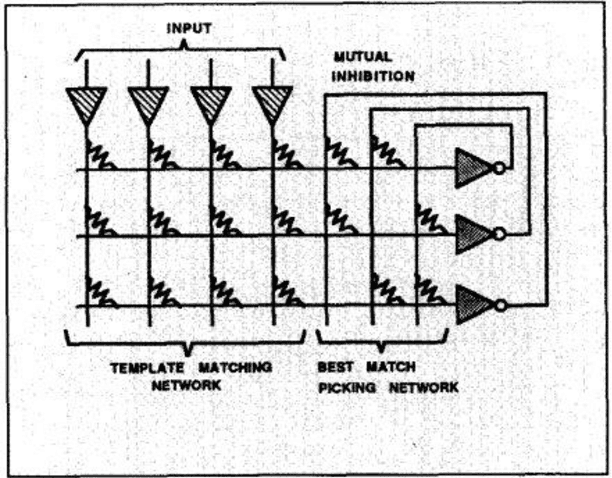
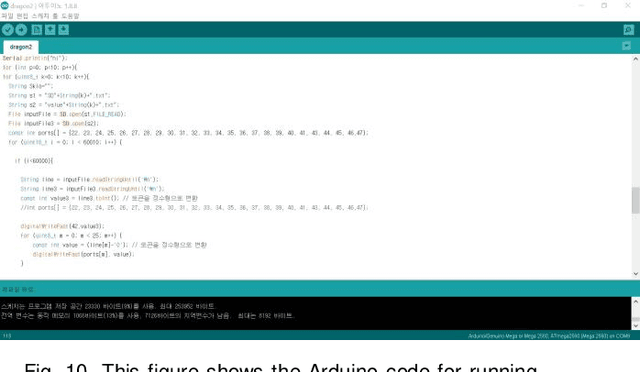
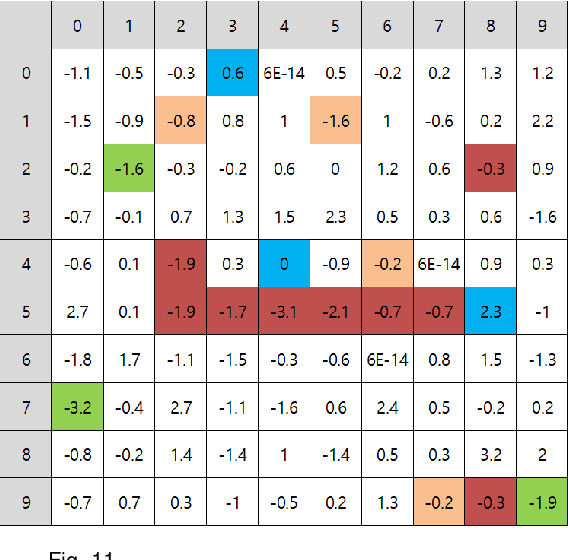
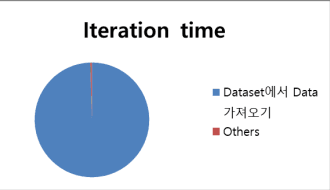
Abstract:There have been many attempts to implement neural networks in the analog circuit. Most of them had a lot of input terms, and most studies implemented neural networks in the analog circuit through a circuit simulation program called Spice to avoid the need to design chips at a high cost and implement circuits directly to input them. In this study, we will implement neural networks using a capacitor and diode and use microcontrollers (Arduino Mega 2560 R3 boards) to drive real-world models and analyze the results.
Style-Guided Inference of Transformer for High-resolution Image Synthesis
Oct 11, 2022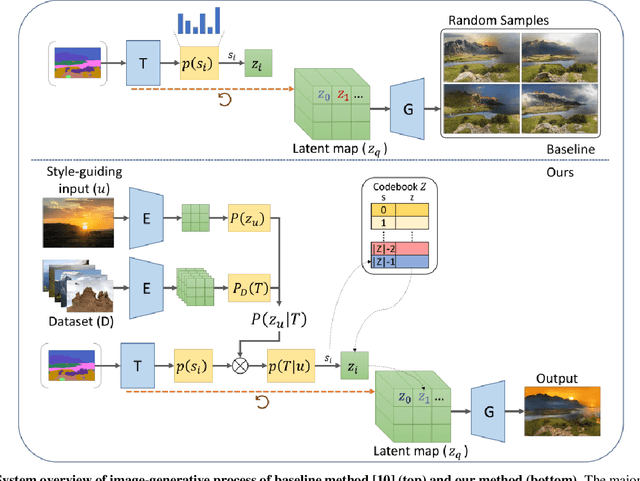
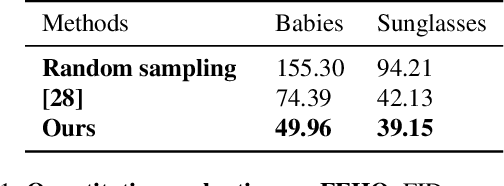
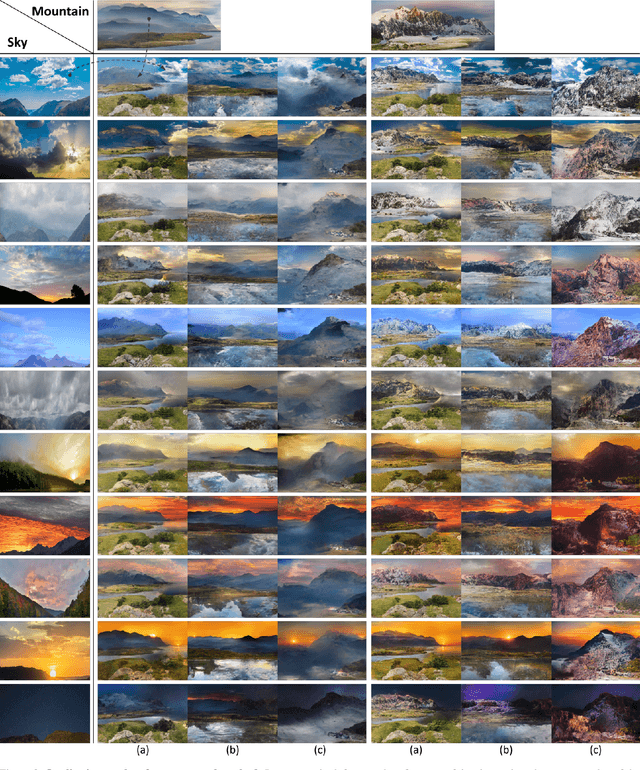
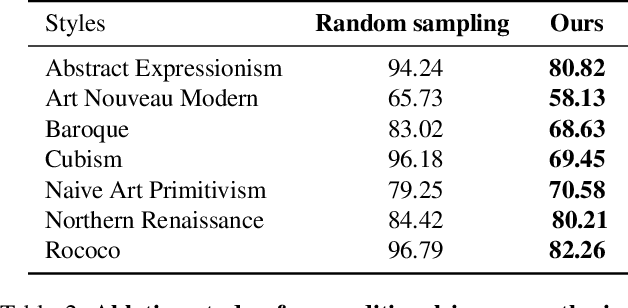
Abstract:Transformer is eminently suitable for auto-regressive image synthesis which predicts discrete value from the past values recursively to make up full image. Especially, combined with vector quantised latent representation, the state-of-the-art auto-regressive transformer displays realistic high-resolution images. However, sampling the latent code from discrete probability distribution makes the output unpredictable. Therefore, it requires to generate lots of diverse samples to acquire desired outputs. To alleviate the process of generating lots of samples repetitively, in this article, we propose to take a desired output, a style image, as an additional condition without re-training the transformer. To this end, our method transfers the style to a probability constraint to re-balance the prior, thereby specifying the target distribution instead of the original prior. Thus, generated samples from the re-balanced prior have similar styles to reference style. In practice, we can choose either an image or a category of images as an additional condition. In our qualitative assessment, we show that styles of majority of outputs are similar to the input style.
StyLandGAN: A StyleGAN based Landscape Image Synthesis using Depth-map
May 13, 2022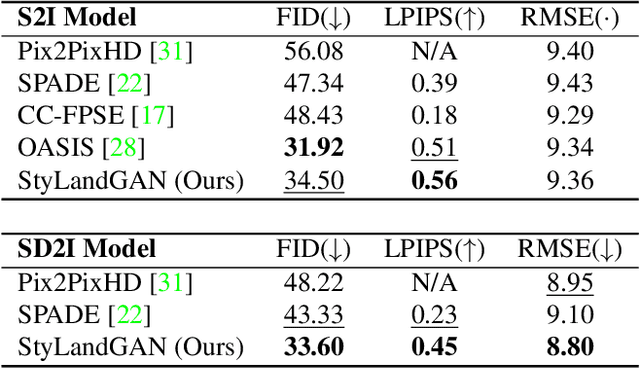
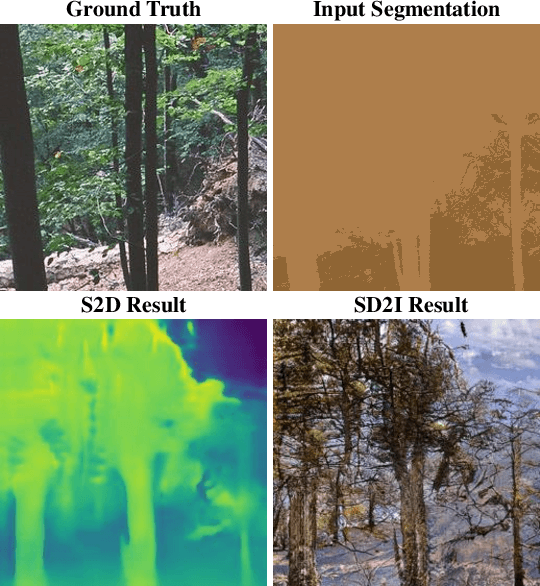
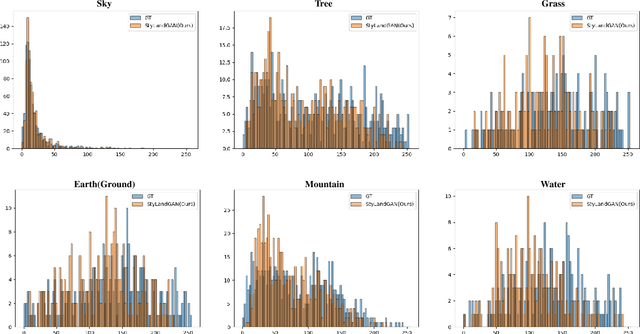
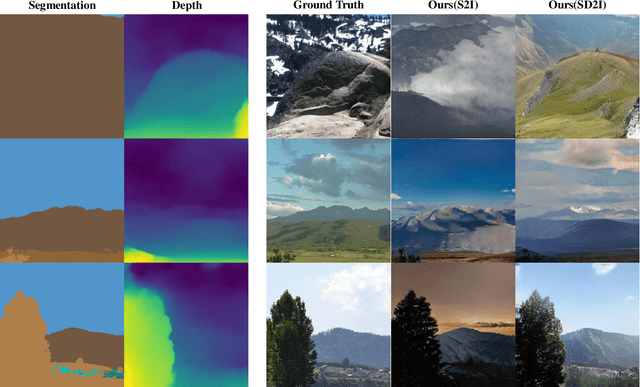
Abstract:Despite recent success in conditional image synthesis, prevalent input conditions such as semantics and edges are not clear enough to express `Linear (Ridges)' and `Planar (Scale)' representations. To address this problem, we propose a novel framework StyLandGAN, which synthesizes desired landscape images using a depth map which has higher expressive power. Our StyleLandGAN is extended from the unconditional generation model to accept input conditions. We also propose a '2-phase inference' pipeline which generates diverse depth maps and shifts local parts so that it can easily reflect user's intend. As a comparison, we modified the existing semantic image synthesis models to accept a depth map as well. Experimental results show that our method is superior to existing methods in quality, diversity, and depth-accuracy.
U-GAT-IT: Unsupervised Generative Attentional Networks with Adaptive Layer-Instance Normalization for Image-to-Image Translation
Jul 25, 2019
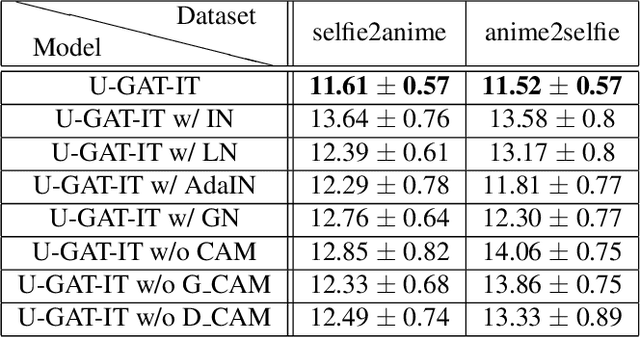
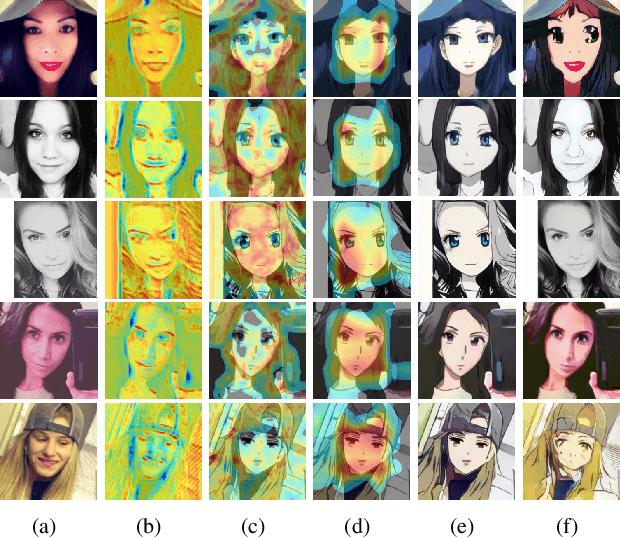

Abstract:We propose a novel method for unsupervised image-to-image translation, which incorporates a new attention module and a new learnable normalization function in an end-to-end manner. The attention module guides our model to focus on more important regions distinguishing between source and target domains based on the attention map obtained by the auxiliary classifier. Unlike previous attention-based methods which cannot handle the geometric changes between domains, our model can translate both images requiring holistic changes and images requiring large shape changes. Moreover, our new AdaLIN (Adaptive Layer-Instance Normalization) function helps our attention-guided model to flexibly control the amount of change in shape and texture by learned parameters depending on datasets. Experimental results show the superiority of the proposed method compared to the existing state-of-the-art models with a fixed network architecture and hyper-parameters.
 Add to Chrome
Add to Chrome Add to Firefox
Add to Firefox Add to Edge
Add to Edge